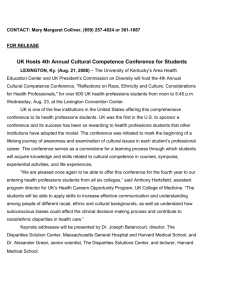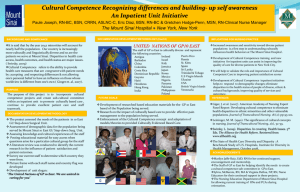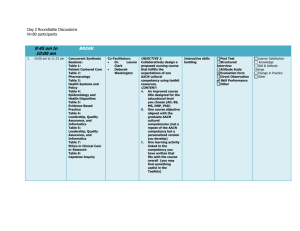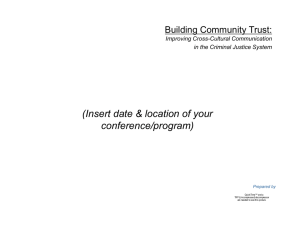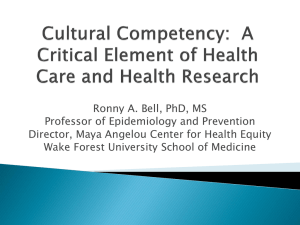Syllabus Cultural Competence - u.osu.edu.chicken
advertisement
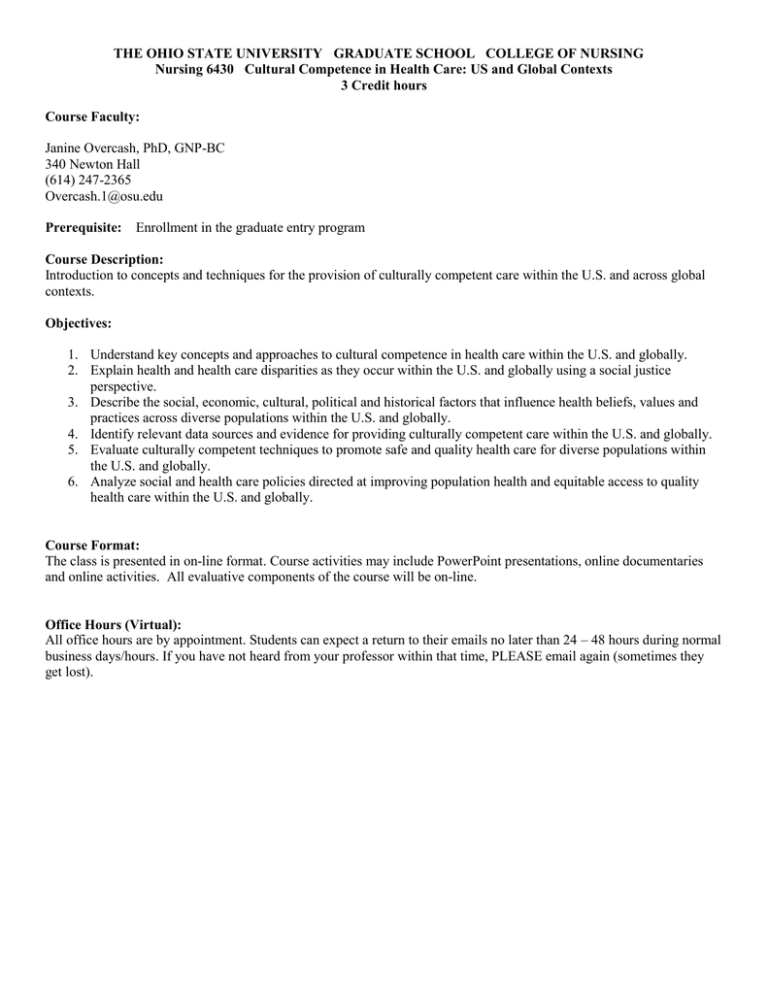
THE OHIO STATE UNIVERSITY GRADUATE SCHOOL COLLEGE OF NURSING Nursing 6430 Cultural Competence in Health Care: US and Global Contexts 3 Credit hours Course Faculty: Janine Overcash, PhD, GNP-BC 340 Newton Hall (614) 247-2365 Overcash.1@osu.edu Prerequisite: Enrollment in the graduate entry program Course Description: Introduction to concepts and techniques for the provision of culturally competent care within the U.S. and across global contexts. Objectives: 1. Understand key concepts and approaches to cultural competence in health care within the U.S. and globally. 2. Explain health and health care disparities as they occur within the U.S. and globally using a social justice perspective. 3. Describe the social, economic, cultural, political and historical factors that influence health beliefs, values and practices across diverse populations within the U.S. and globally. 4. Identify relevant data sources and evidence for providing culturally competent care within the U.S. and globally. 5. Evaluate culturally competent techniques to promote safe and quality health care for diverse populations within the U.S. and globally. 6. Analyze social and health care policies directed at improving population health and equitable access to quality health care within the U.S. and globally. Course Format: The class is presented in on-line format. Course activities may include PowerPoint presentations, online documentaries and online activities. All evaluative components of the course will be on-line. Office Hours (Virtual): All office hours are by appointment. Students can expect a return to their emails no later than 24 – 48 hours during normal business days/hours. If you have not heard from your professor within that time, PLEASE email again (sometimes they get lost). Textbook and Required Readings: Textbook: Fadiman, A. (1997). The Spirit Catches You and You Fall Down. Farrar, Straus and Giroux: New York. Reading/Film List (available on Carmen, unless a URL link is given—then available on-line): Section 1: Diversity & Disparities Module 1: What is Cultural Competence? Bettencourt, JR (2002). Cultural competence in health care: Emerging frameworks and practical approaches. Field Report, The Commonwealth Fund. http://www.commonwealthfund.org/usr_doc/betancourt_culturalcompetence_576.pdf Centers for Disease Control and Prevention (CDC; 2011). Health Disparities and Inequalities Report – United States. Carrillo JE, Green AR, & Betancourt, JR (1999). Cross-cultural primary care: A patient-based approach. Annals of Internal Medicine, 130, 829-834. Clingerman, E. (2011). Social justice: A framework for culturally competent care. Journal of Transcultural Nursing, 22, 334-41. Jones, CP (2000). Levels of racism: A theoretical framework and a gardener’s tale. American Journal of Public Health, 90, 1212-1215. van Ryn, M & Fu, SS (2003). Paved with good intentions: Do public health and human service providers contribute to racial/ethnic disparities in health? American Journal of Public Health, 93, 248 – 255. US Department of Health and Human Services, Office of Minority Health (2009). Ensuring that health care reform will meet the health care needs of minority communities and eliminate health disparities: A statement of principles and recommendations. Module 2: Socioeconomic Status and Social Class Adler, N, Stewart, J, et al. (2007). Reaching for a healthier life: Facts on socioeconomic status and health in the US Bhattacharya, J, DelEire, T., Haider, S., & Currie, J. (2003). Heat or eat? Cold-weather shocks and nutrition in poor American families. American Journal of Public Health, 93, 1149-1154. Lorenc T, Petticrew M, Welch V, Tugwell P., (2012). What types of interventions generate inequalities? Evidence from systematic reviews. Epidemiol Community Health. 2012 Aug 8. [Epub ahead of print] Phelan JC, Link BG, Tehranifar P (2010). Social conditions as fundamental causes of health inequalities: Theory, evidence, and policy implications. Journal of Healht and Social Behavior, 51, S28-40. Spurlock, M. (2005). 30 Days: Living on Minimum Wage. FX Networks. (42 min.) Spurlock, M. (2008). 30 Days: Illegal Immigration. FX Network. (42 min.) Tucker, JN, Grzywacz, JG, Leng, I, Clinch, CR, Arcury, TA (2010). Return to work, economic hardship, and women’s postpartum health. Women & Health, 50, 618-638. Module 3: Race, Ethnicity & Culture Ahmed AT et al. (2007). Racial discrimination and health: Pathways and evidence. Indian Journal of Medical Research, 126, 318-327. Chin MH, Clarke AR, Nocon RS, Casey AA, Goddu AP, Keesecker NM, Cook SC., (2012). A roadmap and best practices for organizations to reduce racial and ethnic disparities in health care. Journal of General Internal Medicine, 27, 992-1000. Elliott, J. (1985). Frontline: A Class Divided (all 5 episodes; 46 minutes): http://www.pbs.org/wgbh/pages/frontline/video/flv/generic.html?s=frol02p66&continuous=1 Hatzfeld JJ, LaVeist TA, Gaston-Johansson FG., (2012). Racial/ethnic disparities in the prevalence of selected chronic diseases among US Air Force members, 2008. Prev Chronic Disease, Epub 2012. Jun 14. Nelson, SC & Hackman, HW (2013). Race matters: Perceptions of race and racism in a sickle cell center. Pediatric Blood Cancer, 60, 451-4. Olshansky, et al. (2012). Differences in life expectancy due to race and educational differences are widening, and many may not catch up. Health Affairs, 31, 1803-12. Padela AI, Killawi A, Forman J, Demonner S, Heisler M. American Muslim Perceptions of Healing: Key Agents in Healing, and Their Roles. Qualitative Health Research. 2012 Perkins RB, Brogly SB, Adams WG, Freund KM., (2012). Correlates of human papillomavirus vaccination rates in low-income, minority adolescents: a multicenter study. Journal of Women’s Health, 21, 813-20. Ransford HE, Carrillo FR, Rivera Y. (2010). Health care-seeking among Latino immigrants: blocked access, use of traditional medicine, and the role of religion. J Health Care Poor Underserved, 21, 862-78. Spurlock, M. (2005). 30 Days: Muslims and America. FX Networks. (42 min.) Module 4: Gender & Gender Identity Celik H, Lagro-Janssen TA, Widdershoven GG, Abma TA, (2011). Bringing gender sensitivity into healthcare practice: a systematic review. Patient Education and Counseling, 84, 143-9. Gill R, Stewart DE., (2011). Relevance of gender-sensitive policies and general health indicators to compare the status of South Asian women's health. Womens Health Issues, 21,12-8. Kanter, R & Caballero, B., (2012). Global gender disparities in obesity: A review. Advances in Nutrition, 3, 4918. Mayer KM, Bradford JB, Makadon HJ, Stall R, Goldhammer H, Landers S. Sexual and gender minority health: what do we know and what needs to be done? AJPH. 2008; 98:989-995. Mollon, L. (2012). The Forgotten Minorities: Health Disparities of the Lesbian, Gay, Bisexual, and Transgendered Communities. J Health Care Poor Underserved, 23, 1-6. Peate I., (2010). The mental health of men and boys: an overview. British Journal of Nursing, 19, 1231-5. Spurlock, M. (2005). 30 Days: Straight Man in a Gay World. FX Networks (42 min) Tyer-Viola LA, Cesario SK. (2010). Addressing poverty, education, and gender equality to improve the health of women worldwide. J Obstet Gynecol Neonatal Nursing, 39, 580-9. Vo DX, Park MJ. (2008). Racial/ethnic disparities and culturally competent health care among youth and young men. Am J Mens Health, 2, 192-205. Module 5: Stigmatizing Condition Brohan, E., Henderson, C., Wheat, K., Malcolm, E., Clement, S., Barley, E.A., et al., (2012). Systematic review of beliefs, behaviours and influencing factors associated with disclosure of a mental health problem in the workplace. BMC Psychiatry, 12, doi:10.1186/1471-244X-12-11. Farley-Toombs C. (2012). The stigma of a psychiatric diagnosis: prevalence, implications and nursing interventions in clinical care settings. Crit Care Nurs Clin North Am, 24, 149-56. Frontline (July 10, 2012). Endgame: AIDS in Black America (2 hours) :http://www.pbs.org/wgbh/pages/frontline/endgame-aids-in-black-america/ Long M, Manktelow R, Tracey A., (2012). We are all in this together: working towards a holistic understanding of self-harm. J Psychiatr Ment Health Nurs, doi: 10.1111/j.1365-2850.2012.01893.x. [Epub ahead of print]. Puhl RM & Heuer CA. (2010). Obesity stigma: Important considerations for public health. AJPH, Jan, e1-e10. Spurlock, M. (2008). 30 Days: Living in a Wheelchair. FX Networks. (42 min) Stewart SM, Simmons A, Habibpour E., (2012). Treatment of culturally diverse children and adolescents with depression. J Child Adolesc Psychopharmacol, 22, 72-9. Williamson L. (2012). Destigmatizing alcohol dependence: the requirement for an ethical (not only medical) remedy. Am J Public Health, 102, e5-8. Section 2: Addressing Diversity and Disparities Module 6: Provider Bias, Health Literacy, Communication & Conflict Provider Bias Greer TM. (2010). Perceived racial discrimination in clinical encounters among African American hypertensive patients. J Health Care Poor Underserved, 21, 251-63. Burgess DJ, Warren J, Phelan S, Dovidio J, van Ryn M.Greer TM. (2010). Stereotype threat and health disparities: what medical educators and future physicians need to know. J Gen Intern Med, 25 Suppl 2:S169-77. Yale (2012). Weight Bias in America. (17 min) http://www.youtube.com/watch?v=lZLzHFgE0AQ Health Literacy: AMA Foundation (2010). Health Literacy and Patient Safety: Help Patients Understand (23 min.) http://www.youtube.com/watch?v=cGtTZ_vxjyA Cornett, S., (Sept. 30, 2009) "Assessing and Addressing Health Literacy" OJIN: The Online Journal of Issues in Nursing Vol. 14, No. 3, Manuscript 2. http://www.nursingworld.org/MainMenuCategories/ANAMarketplace/ANAPeriodicals/OJIN/TableofCo ntents/Vol142009/No3Sept09/Assessing-Health-Literacy-.html Ingram RR. (2012). Using Campinha- Bacote's process of cultural competence model to examine the relationship between health literacy and cultural competence. J Adv Nursing, 68, 695- 704. Health Communication & Conflict: Campinha-Bacote J. (2011). Delivering patient-centered care in the midst of a cultural conflict: the role of cultural competence. Online J Issues Nursing, 16, 5.: http://www.nursingworld.org/MainMenuCategories/ANAMarketplace/ANAPeriodicals/OJIN/TableofCo ntents/Vol142009/No3Sept09/Assessing-Health-Literacy-.html Jefferson Health Care System (2009). Cultural Competence for Health Care Providers (9 min). http://www.youtube.com/watch?v=dNLtAj0wy6I Kodjo, C. (2009). Cultural Competence in Clinician Communication. Pediatrics in Review, 30, 57-64. Teal CR, Street RL. (2009). Critical elements of culturally competent communication in the medical encounter: a review and model. Social Science & Medicine, 68, 533-43. Team 6 (2010). Cultural Communication Conflict – Gestures. (2 min). http://www.youtube.com/watch?v=RykpvFxODGY Module 7: Health & Social Policies Diggs, SN (2012). Health disparities and health care financing: Restructuring the American health care system. Journal of Health Care and Finance, 38, 76-90. Hellander I, (2011). The deepening crisis in US health care: A review of data. Int J Health Serv., 41, 575-586. Knauel, FM, Gonzalez-Pier, E., Gomez-Dantes, O., Garciea-Jnco, D., Arreola-Oranelas, H., Barraza-Llorens, M., et al., (2012). The quest for universal health coverage: Achieving social rotection for all in Mexico. Lancet, epub ahead of print. Opollo JG, Bond ML, Gray J, Lail- Davis VJ. (2012). Meeting tomorrow's health care needs through local and global involvement. J Contin Educ Nurs, 43, 75-80. Spurlock, M. (2005). 30 Days in Jail. FX Network. Spurlock, M. (2008). 30 Days: Life on an Indian Reservation. FX Network. Starfield B, Gérvas J, Mangin D. (2012). Clinical care and health disparities (*). Annu Rev Public Health,33, 89106. Evaluation: Assignment Cultural Self-Assessment This is a questionnaire to determine practitioners’ levels of cultural competence. Available on Carmen under Surveys on the Navigation Bar. For Each Module read the “To Do” List. Please read this to do and refer to the Refer to Grading Criteria for Module Assignments Percent of Grade 5 70 Due Date 9/5/14 by 11:59 pm Final Project: Refer to the Grading Criteria for the Final Project 20 Mod 1: 9/8/14 by 11:59 pm Mod 2: 9/22/14 by 11:59 pm Mod 3: 10/6/14 by 11:59 pm Mod 4: 10/20/14 by 11:59 pm Mod 5: 11/3/14 by 11:59 pm Mod 6: 11/17/14 by 11:59 pm Mod 7: 12/1/14 by 11:59 pm 12/1/14 by 11:59 pm No Stress-No Study Final Exam (don’t bother, you can’t) It will look suspiciously like the cultural competence assessment. This will not be available until the last week of class (Available November 25th) 5 12/9/14 by 11:59 pm Each Module is worth 10 points A note about assignments/evaluation: Assignments and Grading Criteria will be opened to each student after, and only after, they have viewed the Course Orientation Video Pay attention to the Grading Criteria for all assignments—they are your guides for the assignment and the instructors’’ guide for grading You can turn in assignments early. Once a grade is posted on an assignment, it stands. There are no “Do-overs”. Do not wait until the last minute to do these assignments. Late assignments are not accepted. A zero will be earned for any assignment not turned in by the due date unless prior arrangements have been made and approved by the appropriate instructor. Grading Scale: A AB+ 93 – 100% 90 – 92% 87 – 89% B BC+ 83 – 86% 80 – 82% 77 – 79% C CD+ 73 – 76% 70 – 72% 67 – 69% D E 60 – 66% 59% & below Carmen Online Technical Information: This course will use The Ohio State University’s course management system, Carmen. Access to this course will require a username and password. Access NXXX at: https://carmen.osu.edu (the same password used to enroll for classes at the Registrar’s website). Carmen requires the use of your UNIVERSITY login and password. Information concerning your University email and login account can be found at https://acctmgt.service.ohio- state.edu/. As part of Carmen, your homepage after you log in will reflect all courses that you are taking across the University. 24 hour technical support can be reached at: Carmen/TELR - Phone: 614-688-4357 (688-HELP) or through the Carmen Help Web page at: https://telr.osu.edu/carmen/help/index.htm Course content will be available via Carmen. Grades will be posted via Carmen. College of Nursing IT Support For technical support and system requirements for these and other systems you will use while enrolled at the College of Nursing, please visit the College of Nursing Technology Guide at http://go.osu.edu/techguide or e-mail s-help@con.ohiostate.edu. Academic and Professional Misconduct: Students are subject to the provisions in the “Code of Student Conduct” (copies located in: Student Affairs, Room 240 Newton Hall, Office of Student Life, Room 464 Ohio Union or online at http://studentaffairs.osu.edu/resource_csc.asp.) and also the Professional Standards (The OSU CON Student Handbook). Failure to comply with these policies will be handled as outlined in the respective documents Students with Disabilities: Students requesting accommodation for disability for classroom needs are responsible for notifying the Course Head by the end of the first week of the quarter to discuss specific needs. Self-identification is the only way to assure that the faculty member can make the appropriate accommodation. Students should provide a letter from the Office for Disability Services (150 Pomerene Hall, 1760 Neil Avenue; (614) 292-3307; TDD: (614) 292-0901) to verify the disability. Students needing accommodation for temporary physical disabilities or health related reasons should contact the Course Head in order to discuss placement options. Students must be able to perform all job functions as required by the clinical placement site. Students may be asked to provide the Course Head with a letter from their physician indicating physical restrictions or limitations. Module Number 1 Module Topic Module Questions What is Cultural Competence? Define cultural competence What are the major barriers in healthcare? Who are affected by a lack of competence in this area? What are the expectations of health care practitioners in this area? 2 Socioeconomic Status and Social Class What is missing from this literature? What are your views about this topic? What will you take forward as a practitioner? What are the major concerns with disparities in socioeconomic status? How does SES/social class affect health outcomes? What is missing from this literature? What are your views about this topic? What will you take forward as a practitioner? 3 Diversity and Disparities: Race, ethnicity & culture 4 Diversity and Disparities: Gender, sexual orientation What is the difference between race, ethnicity, and culture? What is the influence of race on health disparities? What are the health outcomes attributed to race, ethnicity, and culture? What is missing from this literature? What are your views about this topic? What will you take forward as a practitioner? How do we define diversity and disparities on gender and sexual orientation? What are the major groups of people represented in this module? What are the effects of these on health? What are your views about this topic? What are the biases? Yours? From the literature, etc.? What will you take forward as a practitioner? Module Number 5 6 Module Topic Module Questions Diversity and Disparities: Stigmatizing health conditions What are stigmatizing conditions? How do health care practitioners perpetuate stigma with patients? What are the effects of perpetuating this in the clinical environment? What are your biases that may lead to stigma? What were some of the biases presented in the literature, etc.? What are you going to take forward from this module? Provider Bias, Health Literacy, Communication & Conflict What are provider bias, health literacy, and communication and conflict? How do these impact patient care? What are you biases in these areas? What are biases presented in the literature, etc.? What are you going to take forward with you into practice? 7 Health and social policies How does health policy influence the disparities you have learned about? How do disparities influence health policy? How do biases influence health policy? How do these ultimately impact patient care? What are you biases in these areas? What are biases presented in the literature, etc.? What are you going to take forward with you into practice?
